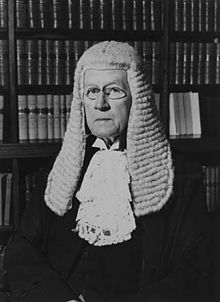John Latham (jurist)
|
The Right Honourable Sir John Latham GCMG QC |
|
|---|---|

Chief Justice Sir John Latham in 1945
|
|
| 5th Chief Justice of Australia | |
|
In office 11 October 1935 – 7 April 1952 |
|
| Nominated by | Joseph Lyons |
| Appointed by | Sir Isaac Isaacs |
| Preceded by | Sir Frank Gavan Duffy |
| Succeeded by | Sir Owen Dixon |
| 9th Leader of the Opposition | |
|
In office 22 October 1929 – 7 May 1931 |
|
| Prime Minister | James Scullin |
| Preceded by | James Scullin |
| Succeeded by | Joseph Lyons |
| 3rd Leader of the Nationalist Party | |
|
In office 22 October 1929 – 7 May 1931 |
|
| Preceded by | Stanley Bruce |
| Succeeded by | Position Abolished |
| Member of the Australian Parliament for Kooyong |
|
|
In office 16 December 1922 – 15 September 1934 |
|
| Preceded by | Robert Best |
| Succeeded by | Robert Menzies |
| Personal details | |
| Born |
26 August 1877 Ascot Vale, Victoria |
| Died | 25 July 1964 (aged 86) Richmond |
| Nationality | Australian |
| Political party |
Liberal Union (1922–1925) Nationalist (1925–1931) UAP (1931–1934) |
| Alma mater | University of Melbourne |
Sir John Greig Latham GCMG QC (26 August 1877 – 25 July 1964) was an Australian judge and politician who served as fifth Chief Justice of the High Court of Australia for seventeen years, from 1935 to 1952.
Latham was born in Ascot Vale, a suburb of Melbourne, Australia. His father was a prominent citizen, whose achievements as secretary for the Society for the Protection of Animals were deeply respected. John Latham won a scholarship and became a successful student at Scotch College and the University of Melbourne, studying logic, philosophy and law. At one point, he was the recipient of the Supreme Court Judges' Prize. In November 1902, Latham became the first secretary of the Boobook Society (named for the southern boobook owl), a group of Melbourne academics and professionals which still meets.
During World War I, he was an intelligence officer in the Royal Australian Navy, holding the rank of lieutenant commander. He was the head of Naval Intelligence from 1917, and was part of the Australian delegation to the Imperial Conference and then the Versailles Peace Conference, for which he was appointed Companion of the Order of St Michael and St George (CMG) in the 1920 New Year Honours. He grew to dislike Prime Minister Billy Hughes.
Latham had a distinguished legal career. He was admitted to the Victorian Bar in 1904, and was made a King's Counsel in 1922. In 1920, Latham appeared before the High Court representing the State of Victoria in the famous Engineers' case, alongside such people as Dr H.V. Evatt and Robert Menzies.
...
Wikipedia
